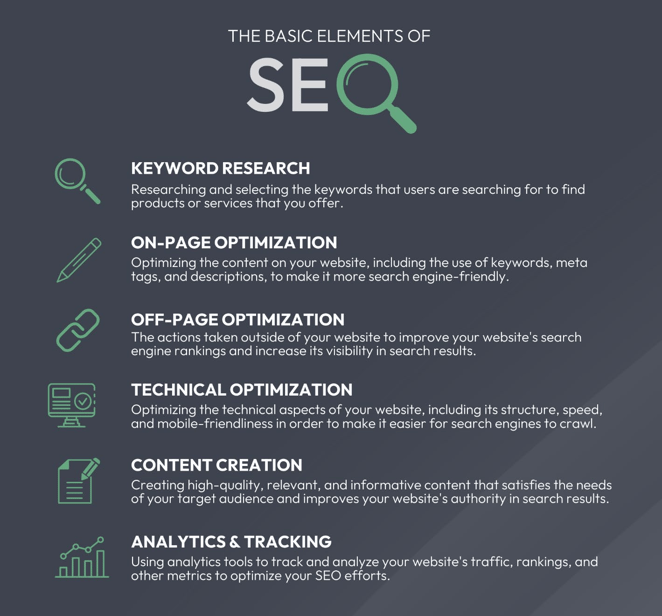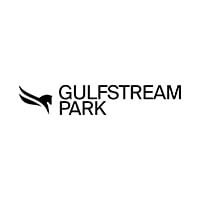
- Our Insights
- Search Engine Optimization - Understanding The Basics
Intro
Search Engine Optimization (SEO) is a vital component of any digital marketing strategy. With the vast majority of online experiences beginning with a search engine query, businesses need to optimize their website for search engines to increase their visibility and attract more traffic. However, SEO can be a complex and ever-evolving field, with new algorithm updates, best practices, and techniques emerging all the time.
This whitepaper outlines the basics of SEO, from keyword research and on-page optimization to link building and analytics. Whether you're new to SEO or looking to refresh your knowledge, this guide will provide you with a solid foundation for improving your website's search engine rankings and online visibility.

SEO is an ongoing process, and it is important to continually monitor and update your website to maintain or improve its ranking on search engines. Let’s go a little deeper into each of the components listed above.
 KEYWORD RESEARCH
KEYWORD RESEARCH
Keyword research is a fundamental aspect of search engine optimization (SEO) that involves identifying the specific words and phrases that people use to search for information online. By understanding what keywords and phrases are most relevant to their target audience, businesses can optimize their website content and other digital assets to appear higher in search engine results pages (SERPs).
- Define your target audience: Before you begin your keyword research, you should have a clear understanding of who your target audience is. This will help you choose keywords that are relevant to them and that they are likely to use when searching for your product or service.
- Brainstorm keywords: Make a list of relevant keywords and phrases that you think your target audience might use to search for your product or service. Include variations of your primary keywords and long-tail keywords (phrases that contain three or more words).
- Use keyword research tools: Use keyword research tools such as Google Keyword Planner, Ubersuggest, or SEMrush to expand your list of keywords and get ideas for new keywords. These tools provide data on search volume, competition, and other metrics that can help you choose the best keywords for your website.
- Analyze the competition: Look at the keywords your competitors are using and analyze their website's content to get ideas for new keywords. This can help you identify gaps in your own keyword strategy and find opportunities to target keywords that your competitors may have overlooked.
- Choose your primary and secondary keywords: Once you have a list of keywords, prioritize them based on relevance, search volume, and competition. Choose a primary keyword and several secondary keywords to target in your website's content.
- Use keywords strategically: Once you've identified your primary and secondary keywords, use them strategically in your website's content, including your page titles, headings, meta descriptions, and body copy. However, avoid keyword stuffing, which can harm your website's SEO performance.
- Monitor and refine your keyword strategy: Use analytics tools such as Google Analytics to monitor your website's performance in search results and make adjustments to your keyword strategy as needed. Keep track of which keywords are driving traffic to your website (and which are not) and adjust your content and keyword targeting accordingly.
By following these steps, you can create a strong keyword strategy that helps drive traffic to your website and improves your website's visibility in search results.
 ON-PAGE OPTIMIZATION
ON-PAGE OPTIMIZATION
On-page optimization is a critical component of search engine optimization (SEO) that involves optimizing individual web pages in order to improve their search engine rankings and drive more organic traffic to your website.
- Optimize your page titles: Your page titles should be descriptive and include your primary keyword. Keep your titles under 60 characters to ensure they display properly in search results.
- Use descriptive headings: Use headings (H1, H2, H3) to structure your content and make it easier for users and search engines to understand. Include your primary keyword in at least one of your headings.
- Optimize your meta descriptions: Your meta descriptions should provide a brief summary of your page's content and include your primary keyword. Keep your descriptions under 155 characters to ensure they display properly in search results.
- Optimize your images: Use descriptive file names and alt tags for your images to help search engines understand the content of your page. Include your primary keyword in at least one of your image file names and alt tags.
- Use internal linking: Link to other pages on your website to help users navigate your site and improve your website's crawlability. Use descriptive anchor text that includes your primary keyword.
- Optimize your URL structure: Use descriptive and concise URLs that include your primary keyword. Avoid using special characters or numbers in your URLs.
- Ensure your website is mobile-friendly: More and more users are accessing websites on mobile devices, so it's important to ensure your website is optimized for mobile. Use a responsive design that adapts to different screen sizes.
- Improve your website's page speed: Users and search engines prefer fast-loading websites. Use a tool like Google PageSpeed Insights to identify areas for improvement and optimize your website's page speed.
By ensuring that each web page is optimized for a specific set of target keywords and phrases, businesses can improve their relevance and visibility in search engine results pages (SERPs).
 OFF-PAGE OPTIMIZATION
OFF-PAGE OPTIMIZATION
Off-page optimization, also known as off-site optimization, refers to the actions taken outside of your website to improve your website's search engine rankings and increase its visibility in search results. It involves building links and promoting your website through various channels on the internet. Off-page optimization is an important part of SEO, as it signals to search engines that other websites consider your website to be a valuable resource and that your website is authoritative in your industry or niche.
Here are some common off-page optimization techniques:
- Link building: Building high-quality inbound links from other websites to your website is one of the most important off-page optimization techniques. Links are like votes of confidence from other websites, and search engines consider them to be a key factor in determining a website's authority and relevance. It's important to focus on building high-quality, relevant backlinks to your website from reputable sources. This can be done through outreach, guest posting, and creating valuable content that other websites want to link to.
- Social media marketing: Promoting your website and its content on social media platforms can help increase visibility and drive traffic to your site. Social media signals, such as likes, shares, and comments, can also signal to search engines that your website is popular and authoritative.
- Influencer marketing: Working with influencers in your industry or niche can help increase your website's visibility and credibility. Influencers can help promote your website and its content to their followers, which can result in increased traffic and inbound links.
- Guest blogging: Writing guest posts for other websites in your industry or niche can help increase your website's visibility and build inbound links. Guest blogging can also help establish you as an authority in your field and build relationships with other bloggers and website owners.
- Online directory listings: Listing your website on online directories can help increase your website's visibility and improve your local search engine rankings. Be sure to choose highquality directories that are relevant to your industry or niche. If your website is linked to lowquality or spammy websites, search engines may see it as an indication that your website is also low-quality or spammy. This can lead to a decrease in your website's ranking on search engine results pages (SERPs), and ultimately, a decrease in traffic to your website.
By implementing these off-page optimization techniques, you can improve your website's authority and relevance in search engines and increase its visibility in search results. However, it's important to remember that off-page optimization is an ongoing process and requires consistent effort and attention over time.
 TECHNICAL OPTIMIZATION
TECHNICAL OPTIMIZATION
Technical optimization in SEO refers to the process of improving the technical aspects of a website to make it easier for search engines to crawl, index, and rank its content. Technical optimization is an important part of SEO because search engines use complex algorithms to evaluate and rank websites, and technical issues can negatively impact a website's search engine visibility.
Here are some common technical optimization techniques:
- Website speed: A website's loading speed is an important ranking factor, and slow-loading pages can negatively impact user experience and search engine rankings. Technical optimization involves minimizing page load times by optimizing image sizes, minimizing server response times, and enabling browser caching.
- Mobile responsiveness: With an increasing number of users accessing the internet on mobile devices, having a mobile-friendly website is crucial for SEO. Technical optimization involves using responsive design techniques to ensure that websites are optimized for different screen sizes and devices.
- Website architecture: A well-structured website architecture makes it easier for search engines to crawl and index your content. Technical optimization involves organizing your website's content into a clear and logical hierarchy, using descriptive URLs, and optimizing your website's internal linking structure.
- Website security: A secure website is important for protecting user data and building trust with your audience. Technical optimization involves using HTTPS encryption, installing security plugins or software, and ensuring that your website is up to date with the latest security patches and updates.
- XML sitemap: An XML sitemap is a file that lists all the pages on your website and helps search engines understand your website's structure. Technical optimization involves creating and submitting an XML sitemap to search engines.
By implementing these technical optimization techniques, you can improve your website's search engine visibility and provide a better user experience for your audience. However, technical optimization can be complex and may require technical expertise or assistance from a web developer or SEO professional.
 CONTENT CREATION
CONTENT CREATION
Content creation is a critical component of SEO, as high-quality content can help improve a website's search engine rankings and drive traffic. By producing high-quality, engaging, and relevant content, businesses can not only improve their website's visibility and authority in search results but also establish themselves as thought leaders in their industry.
Here are some important factors to consider when creating content for SEO:
- Relevance: The content should be relevant to the target audience and answer their questions or provide value to them. Conducting keyword research can help identify topics and phrases that are relevant to your target audience.
- Keyword optimization: Including relevant keywords in your content can help improve your website's visibility in search engines. However, it's important to avoid keyword stuffing, which can negatively impact your rankings.
- Quality: High-quality content that is well-written, informative, and engaging is more likely to be shared and linked to, which can improve your website's authority and search engine rankings.
- Originality: Original content that provides new insights or information is more likely to be shared and linked to, which can improve your website's visibility and authority.
- Formatting: The formatting of the content can impact its readability and user engagement. Use headings, bullet points, and other formatting techniques to break up the content and make it easier to read.
- Multimedia: Including multimedia such as images, videos, and infographics can help make your content more engaging and shareable.
- Length: The length of the content can impact its search engine visibility and user engagement. In general, longer content tends to rank higher in search engines and provide more value to users.
By focusing on these factors when creating content, you can improve your website's search engine visibility, authority, and user engagement. As search engines continue to prioritize high-quality content that meets the needs of users, it is essential for businesses to invest in content creation as a key component of their overall SEO strategy. By focusing on creating valuable, informative, and optimized content, businesses can improve their SEO performance, drive more traffic to their website, and ultimately achieve their marketing goals.
 ANALYTICS & TRACKING
ANALYTICS & TRACKING
When conducting SEO, there are several key metrics and data points that you should track and analyze to evaluate the effectiveness of your strategies and identify areas for improvement.
Here are some examples:
- Organic traffic: Organic traffic refers to the number of visitors who come to your website through search engine results pages (SERPs). Monitoring changes in organic traffic can help you understand how your SEO efforts are impacting your website's visibility and discover potential issues that may be impacting your rankings.
- Keyword rankings: Tracking your keyword rankings can help you evaluate how your content is performing in search engine results pages (SERPs) and identify opportunities for optimization. You can use tools like Google Search Console or SEMrush to monitor keyword rankings.
- Backlinks: Backlinks are links from other websites that point to your website. Tracking backlinks can help you assess the authority of your website and identify opportunities for building new backlinks.
- Conversion rate: Conversion rate refers to the percentage of website visitors who complete a desired action, such as filling out a form or making a purchase. Monitoring your conversion rate can help you understand how your SEO efforts are impacting your bottom line.
- Bounce rate: Bounce rate refers to the percentage of visitors who leave your website after viewing only one page. A high bounce rate can indicate issues with website design, content quality, or targeting.
- Click-through rate (CTR): CTR refers to the percentage of people who click on a link to your website after seeing it in search engine results pages (SERPs). A high CTR can indicate that your title and description tags are effectively targeting your audience.
- Page speed: Page speed refers to how quickly your website loads. Slow loading times can negatively impact user experience and search engine rankings.
By tracking and analyzing these metrics, you can gain valuable insights into how your SEO efforts are performing and identify opportunities for improvement. Regularly monitoring and adjusting your strategies based on data and insights can help maximize your results over time.
Next we will cover the many tools available to track and analyze your SEO efforts, both free and paid subscription models.
SEO
TRACKING & ANALYTICS TOOLS
There are many free tools available to help with SEO. Here are some popular ones:
1. Google Search Console: a free tool that provides valuable insights into how Google crawls and indexes your website, as well as data on search traffic, click-through rates, and keyword rankings. It can also help identify technical issues and opportunities for improving your website's search engine visibility. Here are the main features of Google Search Console:
- Site Verification: Webmasters can verify ownership of their website with Google to gain access to its features and data.
- Search Performance: Webmasters can view how their website is performing in Google search results, including impressions, clicks, and average click-through rate.
- Index Coverage: Webmasters can see which pages on their website have been indexed by Google and identify any indexing errors.
- URL Inspection: Webmasters can submit individual URLs to Google for indexing, see the last crawl date and status of those URLs, and troubleshoot indexing issues.
- Sitemap Submission: Webmasters can submit sitemaps to Google to help Google better understand their website's structure and content.
- Mobile Usability: Webmasters can see how their website performs on mobile devices and identify any issues that may affect the user experience.
- Security Issues: Google Search Console alerts webmasters to any security issues that may affect their website, such as malware or phishing.
- Links: Webmasters can see which websites are linking to their website and which pages on their website are being linked to.
- Rich Results: Webmasters can see which rich results their website is eligible for and how they appear in search results.
2. Bing Webmaster Tools: a free service provided by Microsoft Bing search engine that allows website owners to monitor and manage their website's performance in Bing search results. It provides webmasters with tools and resources to improve their website's visibility in Bing search engine results pages (SERPs). Some of the main features of Bing Webmaster Tools include:
- Site Verification: Webmasters can verify ownership of their website with Bing to gain access to its features and data.
- Search Performance: Webmasters can view how their website is performing in Bing search results, including impressions, clicks, and average click-through rate.
- Keyword Research: Bing Webmaster Tools provides keyword research data, including search volumes and competition levels for keywords related to their website.
- Crawl Control: Webmasters can view how Bing crawls and indexes their website and can submit URLs for indexing.
- Site Map Submission: Webmasters can submit sitemaps to Bing to help Bing better understand their website's structure and content.
- Link Analysis: Bing Webmaster Tools provides insights into the inbound links pointing to their website, including the domains that link to their website and the anchor text used.
3. Keyword research tools: Keyword research tools can help identify relevant keywords and phrases to target in your SEO efforts. These tools can provide data on search volume, competition, and related keywords. There are many free keyword research tools available, but here are some of the top ones:
- Google Keyword Planner: provided by Google Ads and is one of the most popular keyword research tools. It provides keyword ideas, search volume data, and competition levels. (Please note that you need a Google Ads account to use the Keyword Planner tool.)
- Ubersuggest: provides keyword suggestions and related phrases based on the user's input and also provides information on search volume, competition, and CPC.
- Answer The Public: provides keyword suggestions based on questions people are asking on search engines. It also shows related topics and phrases.
- Google Trends: shows the popularity of a keyword over time and can be useful for identifying seasonal trends and changes in search volume.
- Keyword Surfer: Chrome extension that provides keyword suggestions, search volume, and competition levels directly in the Google search results page.
- Moz: provides free SEO tools for link building and analysis, keyword research, webpage performance, local listing audits, and more
4. Analytics tools: Analytics tools such as Google Analytics can provide data on website traffic, user behavior, and conversion rates. This can help identify which pages and keywords are driving the most traffic and conversions, as well as areas for improvement.
There are many fee-based, subscription tools available at varying costs to help with SEO. Here are some popular ones:
1. Ahrefs: a popular SEO toolset that offers a range of features to help website owners and marketers improve their search engine rankings and online visibility. Here are some of the key features that Ahrefs offers:
- Site Explorer: a comprehensive tool that allows users to analyze their own website or any other website for a range of metrics, including backlinks, referring domains, organic search traffic, and top-performing pages.
- Keyword Explorer: provides users with in-depth keyword research and analysis, including search volume data, keyword difficulty scores, and related keyword suggestions.
- Content Explorer: a powerful tool that allows users to search for and analyze content across the web. It provides data on top-performing content, backlinks, and social shares, and can be used to identify content opportunities and trends.
- Rank Tracker: allows users to track their search engine rankings over time, monitor their competitors' rankings, and analyze changes in keyword rankings.
- Site Audit: a comprehensive tool that analyzes a website for technical SEO issues, such as broken links, crawl errors, and duplicate content. It provides detailed reports and suggestions for improvement.
- Backlink Analysis: provides in-depth analysis of a website's backlink profile, including data on referring domains, anchor text, and link quality.
2. Semrush: a popular all-in-one SEO toolset that offers a wide range of features to help website owners and marketers improve their search engine rankings and online visibility. Semrush key features include:
- Keyword Research: advanced keyword research tools that allow users to discover new keyword opportunities, analyze keyword difficulty, and track rankings for target keywords.
- Site Audit: provides a comprehensive technical SEO analysis of a website, highlighting issues that may be impacting search engine rankings.
- Backlink Analysis: provide data on a website's backlink profile, including referring domains, anchor text, and link quality. This data can be used to identify link building opportunities and monitor the impact of backlink campaigns.
- Competitive Analysis: provides a range of competitive analysis tools that allow users to analyze the SEO strategies of their competitors, including organic search rankings, paid search advertising, and content marketing.
- Content Marketing: a suite of tools to help users create and optimize content for SEO, including topic research, content optimization, and content creation tools.
3. Majestic: a well-known backlink analysis tool that offers a range of features to help website owners and marketers improve their SEO and online visibility. The key features that Majestic offers include:
- Backlink Analysis: Majestic's Backlink Analysis tool provides detailed data on a website's backlink profile, including referring domains, anchor text, and link quality. Users can view backlinks for their own website or any other website on the web.
- Site Explorer: Majestic's Site Explorer provides users with in-depth analysis of their own website or any other website on the web. It provides data on referring domains, backlinks, and top-performing pages, and can be used to identify link building opportunities and content ideas.
- Trust Flow and Citation Flow: Majestic's Trust Flow and Citation Flow metrics provide a measure of the quality and quantity of a website's backlinks. Trust Flow measures the quality of a website's backlinks, while Citation Flow measures the quantity of backlinks.
- Keyword Checker: Majestic's Keyword Checker provides users with data on the search volume, difficulty, and potential traffic of specific keywords. It can be used to identify high-traffic keywords and opportunities for content creation and link building.
- Campaigns: Majestic's Campaigns feature allows users to track the progress of their SEO campaigns over time. Users can monitor changes in backlink profiles, Trust Flow and Citation Flow scores, and search engine rankings.
4. Moz Pro: comprehensive SEO toolset that offers a range of products to help website owners and marketers improve their search engine rankings and online visibility. Here are some of the main products that Moz Pro offers:
- Moz Analytics: provides users with a comprehensive view of their website's SEO performance, including keyword rankings, on-page optimization, and backlink profiles.
- Keyword Explorer: provides users with keyword suggestions, search volume data, and keyword difficulty metrics to help users target the most relevant keywords for their website.
- Moz Local: a local SEO tool that allows users to manage their local business listings across the web. Users can update their business information, monitor their reviews, and track their local search rankings.
- Link Explorer: provides users with data on their website's backlink profile, including referring domains, anchor text, and link quality. This data can be used to identify link building opportunities and monitor the impact of backlink campaigns.
- On-Page Grader: analyzes a website's on-page optimization and provides recommendations for improving SEO performance.
- Site Crawl: provides a comprehensive analysis of a website's technical SEO performance, highlighting issues that may be impacting search engine rankings.
5. Serpstat: an all-in-one SEO toolset that offers features such as keyword research, site audit, backlink analysis, and competitor analysis. Here are some of the main tools and features that Serpstat offers:
- Keyword Research: provides users with keyword suggestions, search volume data, keyword difficulty metrics, and keyword trends to help users identify the most relevant and high-traffic keywords for their website.
- Site Audit: provides a comprehensive analysis of a website's technical SEO performance, highlighting issues that may be impacting search engine rankings. This tool checks over 120 on-page and technical SEO factors.
- Backlink Analysis: provides users with data on their website's backlink profile, including referring domains, anchor text, and link quality. This data can be used to identify link building opportunities and monitor the impact of backlink campaigns.
- Competitor Analysis: allows users to analyze their competitors' SEO strategies, including their keywords, backlink profiles, and content marketing strategies.
- Rank Tracking: allows users to track their website's search engine rankings for specific keywords and identify trends over time.
- Content Marketing: provides users with data on popular content topics, as well as insights into how to optimize content for specific keywords and improve engagement.
6. Advance Web Tracking (AWR Cloud): a cloud-based SEO software tool that allows users to monitor their website's search engine rankings across multiple search engines and countries, track their keyword performance, and identify opportunities for improvement in their SEO strategy. Some of the key features of AWR Cloud include:
- Rank Tracking: allows users to track their website's search engine rankings across multiple search engines and countries, and provides detailed reports on their rank positions and changes over time.
- Site Audit: provides a comprehensive analysis of a website's technical SEO performance, highlighting issues that may be impacting search engine rankings.
- Keyword Research: provides users with advanced keyword research tools, allowing them to identify the most relevant and high-traffic keywords for their website and track their performance over time.
- Competitor Analysis: allow users to analyze their competitors' SEO strategies, including their keywords, backlink profiles, and content marketing strategies.
- Customizable Reports: provides users with customizable reports, allowing them to easily share their SEO performance data with clients or team members.
Regularly monitoring and adjusting your strategies based on data and insights can help maximize your results over time. By using these analytics and tracking tools, you can gain valuable insights into your website's performance and identify opportunities for improving your SEO efforts.
In conclusion, effective SEO strategies can help businesses improve their online visibility, drive more traffic to their website, and ultimately increase conversions and revenue. By leveraging a combination of on-page and off-page optimization techniques, businesses can optimize their website for search engines and provide a better user experience for their audience. As search engines continue to evolve, it is essential for businesses to stay up-to-date with the latest trends and best practices in SEO to remain competitive in the digital landscape. With a solid understanding of SEO fundamentals and a commitment to ongoing optimization efforts, businesses can achieve long-term success in their online marketing endeavors.
BONUS CONTENT

STEPS TO SET UP GOOGLE SEARCH CONSOLE:
- Sign into your Google account or create one if you don't have one already.
- Go to the Google Search Console website and click the "Start Now" button.
- Enter your website's URL and click the "Add a Property" button.
- Verify ownership of your website by following one of the available verification methods. There are several methods to verify ownership of your website, including uploading an HTML file to your website, adding a meta tag to your website's HTML code, or verifying ownership through your domain name provider.
- Once you have verified ownership of your website, you will be taken to the Search Console dashboard. Here, you can explore the different sections and features of the tool to help optimize your website's performance in search results.
- You can also set up additional users and grant them access to your Search Console account to collaborate with them on improving your website's SEO.

STEPS TO SET UP BING WEBMASTER TOOLS:
- Go to the Bing Webmaster Tools website and sign in with your Microsoft account. If you don't have one, you can create one for free.
- Click "Add Site" on the homepage and enter your website's URL in the provided field. Click "Add" to proceed.
- Verify ownership of your website by following one of the available verification methods. There are several methods to verify ownership of your website, including adding a meta tag to your website's HTML code or verifying ownership through your domain name provider.
- Once you have verified ownership of your website, you will be taken to the Bing Webmaster Tools dashboard. Here, you can explore the different sections and features of the tool to help optimize your website's performance in Bing search results.
- You can submit your sitemap to Bing Webmaster Tools to help Bing crawl and index your website's pages. To do this, go to the "Configure My Site" section, click "Sitemaps," and then enter the URL of your sitemap.
- You can also use Bing Webmaster Tools to monitor your website's search performance, track your search rankings, and identify potential issues that could be affecting your website's visibility in Bing search results.
Note: It may take some time for Google and Bing to start collecting data about your website after you've set it up. Once data starts to accumulate, you can use the tools to monitor your website's search performance, track your search rankings, and identify potential issues that could be affecting your website's visibility in search results.
LET'S GET TO WORK









